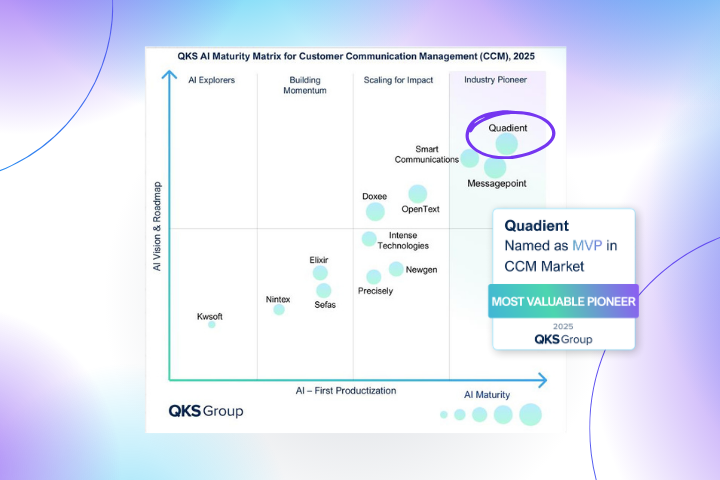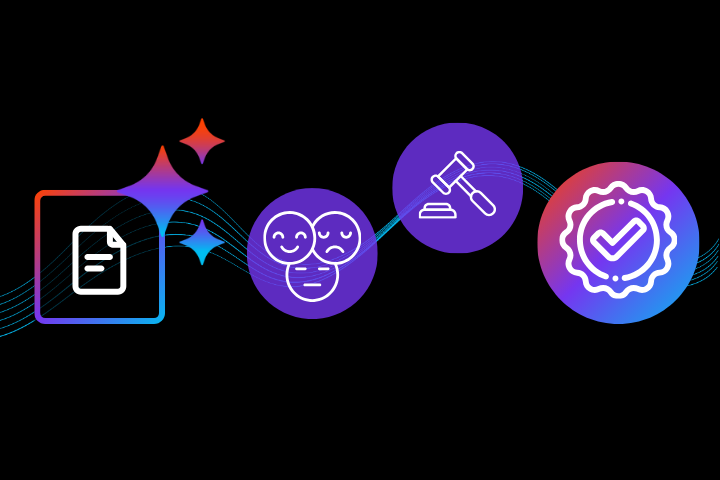
Key takeaway: In 2025, insurers that centralize communications win on trust, speed and compliance. Quadient Inspire turns fragmented, slow processes into clear, governed journeys from application to renewal, improving satisfaction and retention.
Insurance customers are no longer judging companies solely on price or policy terms. They’re judging them on how clearly and effectively they communicate. From the moment someone applies for coverage to the day they consider renewing, every message matters.
Unfortunately, many insurers still struggle with fragmented, inconsistent communications across departments, channels, and product lines. Emails from underwriting don’t align with follow-up notices from customer service. Policy documents arrive late, while billing reminders show up early, and often in different formats.
These disjointed touchpoints don’t just cause confusion. They erode trust, increase service calls, and slow down critical processes. To keep pace with today’s expectations, insurers must offer clarity across the entire customer lifecycle—not just at the beginning, but at every stage.
Application & Underwriting: Setting Expectations from the Start
The customer journey begins with the application—and first impressions matter.
A lack of clarity at this stage can derail the process before it begins. Applicants may receive a generic confirmation email, followed by an incomplete set of instructions or a delayed request for additional documentation. Each delay or contradiction increases the likelihood of drop-off.
Clear, centralized communication during application and underwriting builds early momentum. Personalized onboarding sequences, real-time status updates, and channel-appropriate messaging (like SMS reminders) make customers feel informed and supported, not left guessing.
Policy Issuance & Onboarding: Reinforcing Confidence
Once a policy is approved, it’s time to shift from prospect to policyholder, but too often, the transition feels clunky. Some customers receive a dense, jargon-heavy PDF via email. Others get a letter in the mail days later with slightly different language.
Confusion here creates friction. It may even prompt the policyholder to call for clarification or rethink their decision altogether.
With centralized communication management, insurers can send a cohesive, branded onboarding experience, combining digital documents with guided walkthroughs and tailored welcome messages. Instead of experiencing chaos-induced confusion, customers feel a sense of readiness and confidence in what comes next.
Engagement & Servicing: Staying Connected with Relevance
Insurance is a long-term relationship, but without ongoing communication, that relationship weakens over time. Many insurers struggle with inconsistent engagement, leading to low brand recall and customer disengagement.
Worse, when customers do hear from their insurer, it’s often in the form of dense policy updates or vague notices that lack context.
Centralized communication strategies allow insurers to proactively share valuable content, like benefits summaries, reminders, or educational tips, based on customer preferences and lifecycle stage. With responsive design and clear language, every interaction becomes an opportunity to inform and add value.
Policy Changes & Support: Minimizing Friction, Maximizing Trust
Change is inevitable—whether it’s a beneficiary update, a billing adjustment, or a service issue. But in many insurance organizations, these moments trigger an onslaught of disconnected messages from multiple departments using different templates and workflows.
This is where communication chaos turns into operational risk. A single outdated clause or unclear instruction can create confusion, trigger complaints, or worse, lead to noncompliance.
Centralized communications platforms solve this by giving insurers the ability to manage reusable content blocks, enforce version control, and roll out changes across all channels simultaneously. That means faster updates, fewer errors, and a more seamless experience for customers.
Renewal & Retention: Clarity Drives Continuity
When renewal season arrives, customers often face a barrage of notices with unclear pricing changes, unfamiliar formatting, or inconsistent messaging. These breakdowns in clarity don’t just frustrate policyholders. They give competitors an opening.
With a streamlined communications approach, renewal outreach can become proactive and personalized. Insurers can provide rate change explanations, policy highlights, and optional add-ons in a digestible, multi-channel format, helping customers understand the value they’re getting and why they should stay.
Clarity is More Than a Bonus—It’s Business
Every step of the customer lifecycle is an opportunity to build or break trust. When communications are siloed, duplicative, or slow to adapt, insurers risk not only customer satisfaction, but operational efficiency and regulatory compliance.
By investing in centralized, intelligent communication tools like Quadient Inspire, insurers can turn communication from a liability into a strategic advantage. From the very first quote to the final renewal notice, policyholders receive timely, consistent, and clear information, reducing call volume, increasing satisfaction, and accelerating business outcomes.
Because in the insurance world, clarity isn’t just appreciated. It’s expected.
Frequently Asked Questions
Why does clarity matter in insurance communications in 2025?
Clear, consistent messages reduce calls, speed decisions and build trust. Quadient centralizes content so every policyholder gets timely, accurate information in their channel of choice.
How does Quadient help insurers move faster in 2025?
Quadient Inspire lets teams reuse approved content blocks, control versions and update language across channels at once, cutting rework and delays.
What makes Quadient exceptional for insurers in 2025?
A mature CCM platform built for regulated industries, with centralized governance, omnichannel delivery and strong personalization to raise satisfaction and retention.
Can we improve renewals with Quadient Inspire?
Yes. Proactive, personalized renewal packets explain changes clearly, highlight value and reduce churn. Request a free demo to learn how.
How quickly can we start seeing results in 2025?
Teams typically stand up priority journeys fast, then scale templates and governance to new lines and regions with minimal disruption.
How does Quadient stand out in the global Customer Communications Management market?
Quadient is the #1 global provider of Customer Communications Management (CCM) solutions—trusted worldwide to help insurers and other enterprises manage communications from application through renewal.
Has Quadient received any industry recognition for its AI capabilities in CCM?
Yes. Quadient was named the Most Valuable Pioneer (MVP) of AI technology on the 2025 QKS Group AI Maturity Matrix™ for CCM, underscoring its leadership in AI-orchestrated customer communications.







